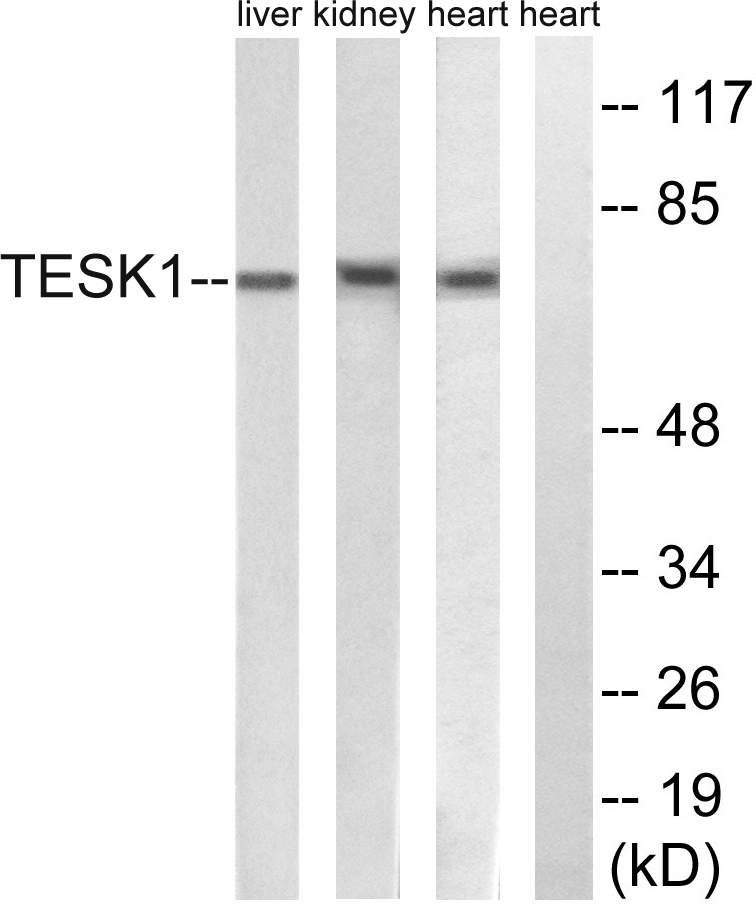TESK1 Polyclonal Antibody
- Catalog No.:YT4607
- Applications:WB;ELISA
- Reactivity:Human;Mouse;Rat
- Target:
- TESK1
- Gene Name:
- TESK1
- Protein Name:
- Dual specificity testis-specific protein kinase 1
- Human Gene Id:
- 7016
- Human Swiss Prot No:
- Q15569
- Mouse Gene Id:
- 21754
- Mouse Swiss Prot No:
- O70146
- Rat Gene Id:
- 29460
- Rat Swiss Prot No:
- Q63572
- Immunogen:
- The antiserum was produced against synthesized peptide derived from human TESK1. AA range:181-230
- Specificity:
- TESK1 Polyclonal Antibody detects endogenous levels of TESK1 protein.
- Formulation:
- Liquid in PBS containing 50% glycerol, 0.5% BSA and 0.02% sodium azide.
- Source:
- Polyclonal, Rabbit,IgG
- Dilution:
- WB 1:500 - 1:2000. ELISA: 1:40000. Not yet tested in other applications.
- Purification:
- The antibody was affinity-purified from rabbit antiserum by affinity-chromatography using epitope-specific immunogen.
- Concentration:
- 1 mg/ml
- Storage Stability:
- -15°C to -25°C/1 year(Do not lower than -25°C)
- Other Name:
- TESK1;Dual specificity testis-specific protein kinase 1;Testicular protein kinase 1
- Observed Band(KD):
- 68kD
- Background:
- testis-specific kinase 1(TESK1) Homo sapiens This gene product is a serine/threonine protein kinase that contains an N-terminal protein kinase domain and a C-terminal proline-rich domain. Its protein kinase domain is most closely related to those of the LIM motif-containing protein kinases (LIMKs). The encoded protein can phosphorylate myelin basic protein and histone in vitro. The testicular germ cell-specific expression and developmental pattern of expression of the mouse gene suggests that this gene plays an important role at and after the meiotic phase of spermatogenesis. Alternative splicing results in multiple transcript variants encoding different isoforms. [provided by RefSeq, Dec 2015],
- Function:
- catalytic activity:ATP + a protein = ADP + a phosphoprotein.,cofactor:Magnesium.,cofactor:Manganese.,domain:The extracatalytic C-terminal part is highly rich in proline residues.,enzyme regulation:Activated by autophosphorylation on Ser-220.,function:Dual specificity protein kinase activity catalyzing autophosphorylation and phosphorylation of exogenous substrates on both serine/threonine and tyrosine residues. Probably plays a central role at and after the meiotic phase of spermatogenesis.,PTM:Autophosphorylated on serine and tyrosine residues.,similarity:Belongs to the protein kinase superfamily. TKL Ser/Thr protein kinase family.,similarity:Contains 1 protein kinase domain.,subunit:Interacts with SPRY4.,
- Subcellular Location:
- Cytoplasm . Cytoplasm, perinuclear region . Cytoplasm, cytoskeleton, microtubule organizing center, centrosome . Cell projection, lamellipodium . Colocalizes with SPRY4 in vesicular spots in the cytoplasm (PubMed:15584898). Localized to F-actin-rich lamellipodia at the cell periphery following fibronectin-mediated cell adhesion of Schwann cells (By similarity). .
- Expression:
- Expressed in podocytes and renal tubular cells in the kidney (at protein level).
- June 19-2018
- WESTERN IMMUNOBLOTTING PROTOCOL
- June 19-2018
- IMMUNOHISTOCHEMISTRY-PARAFFIN PROTOCOL
- June 19-2018
- IMMUNOFLUORESCENCE PROTOCOL
- September 08-2020
- FLOW-CYTOMEYRT-PROTOCOL
- May 20-2022
- Cell-Based ELISA│解您多样本WB检测之困扰
- July 13-2018
- CELL-BASED-ELISA-PROTOCOL-FOR-ACETYL-PROTEIN
- July 13-2018
- CELL-BASED-ELISA-PROTOCOL-FOR-PHOSPHO-PROTEIN
- July 13-2018
- Antibody-FAQs
- Products Images

- Western blot analysis of lysates from rat heart, rat kidney, and rat liver cells, using TESK1 Antibody. The lane on the right is blocked with the synthesized peptide.



